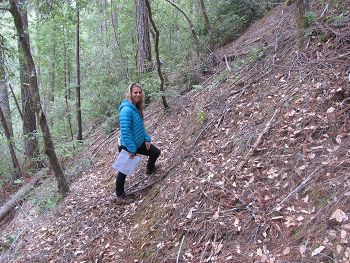Critical Zone Profile - DANIELLA REMPE (hydrologist, geomorphologist, PhD student)
Scientists don’t yet fully understand how the critical zone is structured and what controls the movement of water and nutrients through the subsurface system that supports life. Studying the critical zone directly helps us understand how this zone evolves and how it affects hydrologic and ecologic processes.
Daniella Rempe seeks to understand the mechanisms by which water is stored and transported in the fractured weathered bedrock that underlies landscapes. For example, plants in mountainous regions often derive their moisture from rock, rather than from soil. Rempe studies how water moves through weathered rock and where we might expect weathered bedrock to influence hydrologic dynamics. She makes field observations about “rock moisture,” a term that refers to the seasonal moisture held in fractured, weathered bedrock.
In the Eel River CZO scouting for geophysical lines to image the hillslope interior. Photo credit: William E. Dietrich.
“One important mission for CZ scientists is to seek generality despite the complexities and heterogeneities of the system we work in. We are hypothesis driven and, through collaboration, we can think beyond our single discipline and single site.” – Daniella Rempe
One issue of importance to communities in northern California is how low-flow conditions in streams (the minimum discharge at the end of the dry season) is affected by land use changes, such as illegal water extraction for marijuana growing or changes in vegetation due to fire. I have demonstrated that the storage of water in fractured weathered bedrock is important to moderating when water arrives in stream channels. The more we continue to quantify the timing and controls on this water source to streams, the better we can predict low-flow conditions and their effects on the aquatic ecosystems that are important to the community.
My work is relevant to ecologists because patterns of water availability and the dissolved constituents within water influence vegetation, microbes, and aquatic ecosystems – all of which influence food web dynamics. My work is important to the larger human community because we need to understand the timing and availability of water resources that we rely on.
Unfortunately, it seems that critical zone issues enter public consciousness when resources are degraded. I think the CZO network has an opportunity to demonstrate how an understanding of the evolution and function of the critical zone leads to the prevention of resource degradation.
The CZO network has been important to my work in several ways:
- Networking and synthesis: Through CZO meetings, I have been given an opportunity to connect with other researchers with similar interests, bring together existing datasets, and share a vision for future data collection.
- New observations: Through direct observations and targeted studies, CZO sites have generated new data that provide modeling targets and lead to new hypotheses about how subsurface hydrology works.
- A place to test hypotheses: The CZO network of instrumented, heavily studied sites allows me to test hypotheses that have been generated through my work. For example, I can collaborate with others who have drilled deep holes at other CZOs to try to understand how weathering and moisture storage are related.
Following a forest fire to investigate how burning of roots changes subsurface porosity and permeability structure. Photo credit: William E. Dietrich.
The greatest challenges I face in my work are making observations in the subsurface. We can measure samples that we bring back to a lab and we can make measurements in the field in places that we can access, but it remains very challenging to directly observe processes that occur in the subsurface. As a result, we lack data on the structure of the critical zone under landscapes. Is there a relationship between topography and the depth of the weathering front? We need to continue to probe the subsurface and make direct observations to understand what individual geophysical measurements tell us about the processes occurring beneath the Earth’s surface.
I enjoy visiting local classrooms as part of a program called BASIS, Bay Area Scientists In Schools, and teaching about critical zone processes. With fellow geology graduate students, I teach a lesson on mountain building and erosion and help students understand why we find fossils at the top of Mt. Everest. Our students learn about the forces that shape the world around them, and it’s a blast to engage with them about local issues. I’m always surprised at how interested they are in what I do day-to-day, so it’s a real treat to talk to them about my research. They are excited to learn that there are jobs where you can spend a lot of time playing in the dirt or climbing tall trees.
:: By Linda Copman, staff writer ::
In the Eel River CZO scouting for geophysical lines to image the hillslope interior. Photo credit: William E. Dietrich.
Following a forest fire to investigate how burning of roots changes subsurface porosity and permeability structure. Photo credit: William E. Dietrich.
News Category:
RESEARCH |
PEOPLE |
EDUCATION/OUTREACH
Related News
Explore Further







